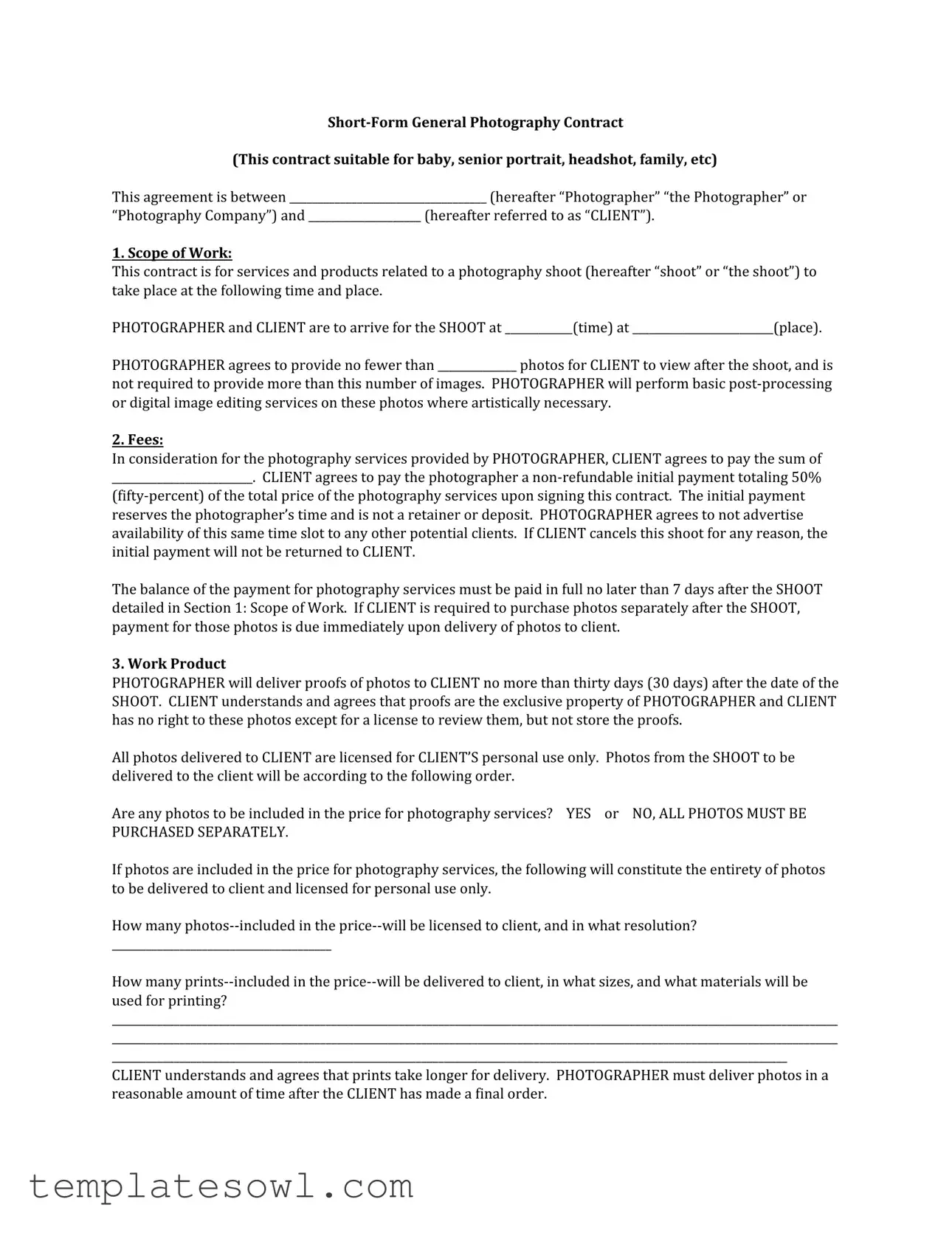Short-Form General Photography Contract
(This contract suitable for baby, senior portrait, headshot, family, etc)
This agreement is between ___________________________________ (hereafter “Photographer” “the Photographer” or
“Photography Company”) and ____________________ (hereafter referred to as “CLIENT”).
1. Scope of Work:
This contract is for services and products related to a photography shoot (hereafter “shoot” or “the shoot”) to take place at the following time and place.
PHOTOGRAPHER and CLIENT are to arrive for the SHOOT at ____________(time) at _________________________(place).
PHOTOGRAPHER agrees to provide no fewer than ______________ photos for CLIENT to view after the shoot, and is
not required to provide more than this number of images. PHOTOGRAPHER will perform basic post-processing or digital image editing services on these photos where artistically necessary.
2. Fees:
In consideration for the photography services provided by PHOTOGRAPHER, CLIENT agrees to pay the sum of
_________________________. CLIENT agrees to pay the photographer a non-refundable initial payment totaling 50%
(fifty-percent) of the total price of the photography services upon signing this contract. The initial payment reserves the photographer’s time and is not a retainer or deposit. PHOTOGRAPHER agrees to not advertise availability of this same time slot to any other potential clients. If CLIENT cancels this shoot for any reason, the initial payment will not be returned to CLIENT.
The balance of the payment for photography services must be paid in full no later than 7 days after the SHOOT detailed in Section 1: Scope of Work. If CLIENT is required to purchase photos separately after the SHOOT, payment for those photos is due immediately upon delivery of photos to client.
3. Work Product
PHOTOGRAPHER will deliver proofs of photos to CLIENT no more than thirty days (30 days) after the date of the SHOOT. CLIENT understands and agrees that proofs are the exclusive property of PHOTOGRAPHER and CLIENT has no right to these photos except for a license to review them, but not store the proofs.
All photos delivered to CLIENT are licensed for CLIENT’S personal use only. Photos from the SHOOT to be delivered to the client will be according to the following order.
Are any photos to be included in the price for photography services? YES or NO, ALL PHOTOS MUST BE PURCHASED SEPARATELY.
If photos are included in the price for photography services, the following will constitute the entirety of photos to be delivered to client and licensed for personal use only.
How many photos--included in the price--will be licensed to client, and in what resolution?
_______________________________________
How many prints--included in the price--will be delivered to client, in what sizes, and what materials will be used for printing?
_________________________________________________________________________________________________________________________________
_________________________________________________________________________________________________________________________________
________________________________________________________________________________________________________________________
CLIENT understands and agrees that prints take longer for delivery. PHOTOGRAPHER must deliver photos in a reasonable amount of time after the CLIENT has made a final order.
4. Indemnification:
4.1- PHOTOGRAPHER and CLIENT agree that PHOTOGRAPHER is under no obligation to capture any specific moment or pose or person(s) during the SHOOT.
4.2- If PHOTOGRAPHER is unable to perform the services in this contract due to any cause outside its control, client agrees to indemnify photographer for any loss damage or liability; however, PHOTOGRAPHER will return in full all payments made by CLIENT to PHOTOGRAPHER in relation to this SHOOT.
4.3- CLIENT agrees to indemnify and hold harmless PHOTOGRAPHER for any liability, damage, or loss related to technological failure, including data loss.
4.4- CLIENT understands and agrees that PHOTOGRAPHER is not required to maintain copies of the photos from this shoot 60 (sixty) days after the photos have been delivered to CLIENT.
4.5– CLIENT agrees to hold PHOTOGRAPHER harmless for any personal injury which may occur as the CLIENT poses or works with PHOTOGRAPHER.
4.6– PHOTOGRAPHER will strive to present photos in a workmanlike manner but is not required to cater to specific aesthetic preferences of CLIENT.
5. Duty of Client
CLIENT will obtain all permissions necessary for PHOTOGRAPHER to photograph at the SHOOT. PHOTOGRAPHER has no duty to obtain permission of reception centers, churches, buildings, properties, or other locations to operate thereon. CLIENT understands and agrees that any failure to obtain these permissions resulting in fines to photographer, or which prevent photographer from photographing the event(s) is not the fault, liability, or responsibility of photographer.
6. Exclusive Photographer
CLIENT agrees and understands that no other party other than PHOTOGRAPHER may take pictures of any poses, lighting situations, or setups made by the photographer. This slows down the photographer’s work and violates the photographer’s right to take pictures of the event. CLIENT agrees to take responsibility for insisting that no person(s) get in the way of the PHOTOGRAPHER or take pictures in these situations.
7. Model Release
CLIENT grants permission to PHOTOGRAPHER and its assigns, licensees, and sublicensees, permission to use CLIENT’S image or likeness in any and all forms of media for commercial purposes, advertising, trade, personal use, or any and all other uses. Therefore, PHOTOGRAPHER may use CLIENT’S likeness and image on PHOTOGRAPHER’S website or other advertising. PHOTOGRAPHER may sell photos containing CLIENT’S likeness to third parties.
9. Assignability and Parties of Interest:
CLIENT agrees and understands that, unless otherwise specified in this Contract, CLIENT is not contracting for a personal service that will be performed by any specific photographer. PHOTOGRAPHER may sub-contract or assign this contract to any second-shooter, PHOTOGRAPHER may assign any photographers associated with the PHOTOGRAPHY COMPANY to perform its duties under this contract. All photographers must be capable and competent to perform the services in a workmanlike manner.
PHOTOGRAPHER Signature __________________________________________________ Date: ___________________________
CLIENT Signature: ______________________________________________________________ Date: ____________________________
